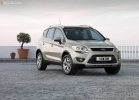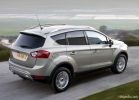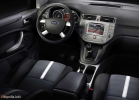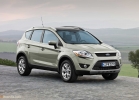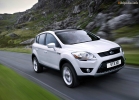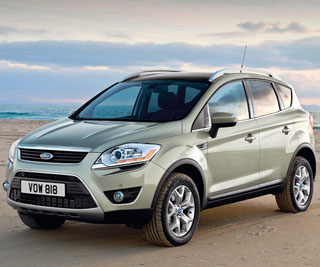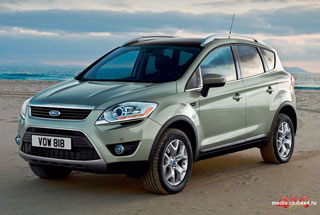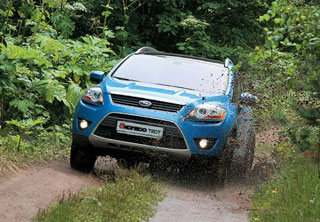Test drive Ford Kuga since 2008 SUV
Intvents
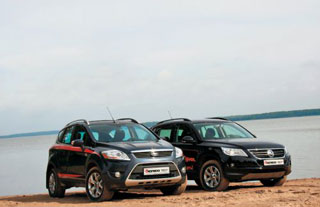 Ford Kuga. Price: from 881000 rubles. On sale: since July 2008
Ford Kuga. Price: from 881000 rubles. On sale: since July 2008 VW Tiguan. Price: from 904000 rubles. On sale: since August 2008
Both Ford Kuga and VW Tiguan are newcomers in the Russian market. It is all the more interesting to compare them even before they fill our roads
Ford Kuga
The basis for Ford Kuga was the Ford Focus/C-Max platform. And with the last Kuga model has much more in common than with Focus. In particular, the salons of these cars are actually identical. As for the all -wheel drive, it is borrowed for this model from the Volvo S40/V50. Officially, only a 2.0 -litful turbodiesel is still available.
Driving
The dynamics, which endow the car diesel engine, deserves praise. But on off -road, there is a lack of torque at low speeds.
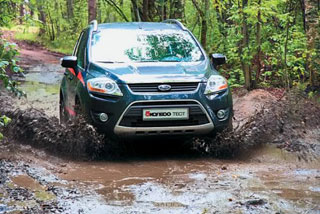 Salon
Salon Interesting. However, the driver may lack space.
Comfort
One of the arguments of skeptics about the presence of a diesel engine on a car is completely soundproofing.
Security
The basic equipment is quite competent.
Price
Reasonable.
 VW Tiguan
VW Tiguan Volkswagen Tiguan is very much like his older brother Touareg, but, in contrast to him, it can be both full and monotive. Today, the car is offered in two modifications. Track & Field and Sport & Style provide various features of geometric cross -country ability, and also provide the opportunity to choose a design machine.
Driving
With sharp restructuring, there is a slight lead from the trajectory due to the high profile of the tires during this configuration. Dynamics and brake system deserve a good assessment.
Salon
The salon is simple, but kind. Equally spacious for all passengers. Provides ample transformation opportunities.
Comfort
At the level of classmates.
Security
The basic equipment effectively protects the driver of the Ipassences.
Price
Highly.
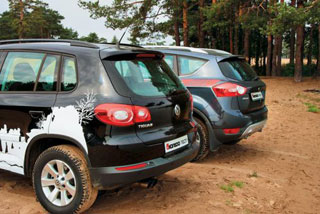 The feeling is that it will pass for another five or six years and there will be no other cars on the roads, except for crossovers. Today they are not in the production program, perhaps only the lazy. Even AvtoVAZ thought about a car of this class and showed it this year at the Moscow Motor Show. What can we say about more eminent manufacturers. But if the VAZ C-Cross is only a concept with a muddy future, then Ford Kuga and VW Tiguan are quite tangible and are already in the show rooms of official dealers. Outwardly, Tiguan is very reminiscent of his older brother Touareg. However, it is still impossible to call it a one hundred percent reduced copy of the latter. Designers managed to bring individuality into his appearance and thereby passing one hundred percent similarity.
The feeling is that it will pass for another five or six years and there will be no other cars on the roads, except for crossovers. Today they are not in the production program, perhaps only the lazy. Even AvtoVAZ thought about a car of this class and showed it this year at the Moscow Motor Show. What can we say about more eminent manufacturers. But if the VAZ C-Cross is only a concept with a muddy future, then Ford Kuga and VW Tiguan are quite tangible and are already in the show rooms of official dealers. Outwardly, Tiguan is very reminiscent of his older brother Touareg. However, it is still impossible to call it a one hundred percent reduced copy of the latter. Designers managed to bring individuality into his appearance and thereby passing one hundred percent similarity. Kuga was more fortunate. The artists who did not have anything similar at hand had to not draw, but draw a car from scratch. This is what allowed the car to become unlike everything that Ford was still done. Of course, family features are also guessed in his appearance, but you will no longer be able to confuse Kuga with something that has appeared in the production program of such a famous brand. The car turned out to be quite original and somewhat aggressive. Tiguan looks much more modest in this regard, and this is provided that on the test we had a machine in the TRACK & FILD configuration, which implies the presence of not only an activated lifting system/descent help system and new ABS system algorithms, but also other front and rear bumper with smaller overhangs. Here you need to explain that there is also Sport & Style configuration, whose body kit is not so utilitated.
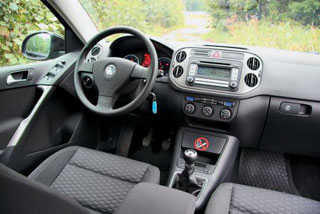 Tiguan does not put pressure on the psyche and bells and whistles in the cabin. Everything is quite modest, but very practical. The scale of the instrument panel does not overload the driver with excess information, the audio control unit is simple and understandable, and even a child can understand how to configure the operation of a climate installation in the right way. Only a large number of deflectors on the front panel are as much as eight pieces are somewhat puzzled. Which, however, has a completely reasonable background. Distributed correctly air flows in Tiguan will not be labor. There are such for the rear passengers, though their number is limited only by two. Since it was about places in the second row, it is worth noting that the back row of Tiguan, unlike Kuga, just like the front seats, can move in a longitudinal direction. This allows you to find a reasonable compromise between the place allotted for the belongings in the trunk and the comfortable stay of passengers in the second row. By the way, due to this, the trunk of the smaller Tiguan size is much more spacious than that of Kuga. Although the luggage can be loaded not only through the open door in Ford, but also through the open glass, which is very convenient in conditions of dense parking.
Tiguan does not put pressure on the psyche and bells and whistles in the cabin. Everything is quite modest, but very practical. The scale of the instrument panel does not overload the driver with excess information, the audio control unit is simple and understandable, and even a child can understand how to configure the operation of a climate installation in the right way. Only a large number of deflectors on the front panel are as much as eight pieces are somewhat puzzled. Which, however, has a completely reasonable background. Distributed correctly air flows in Tiguan will not be labor. There are such for the rear passengers, though their number is limited only by two. Since it was about places in the second row, it is worth noting that the back row of Tiguan, unlike Kuga, just like the front seats, can move in a longitudinal direction. This allows you to find a reasonable compromise between the place allotted for the belongings in the trunk and the comfortable stay of passengers in the second row. By the way, due to this, the trunk of the smaller Tiguan size is much more spacious than that of Kuga. Although the luggage can be loaded not only through the open door in Ford, but also through the open glass, which is very convenient in conditions of dense parking. As already mentioned, Kuga, albeit slightly, but still more Tiguan, however, when you get behind the wheel of a car, this sensation is not. As soon as the door slamms, the driver finds himself in a certain similarity of the racing cockpit. The widespread central console is to blame. It not only dominates everything else visually, but also really limits the freedom of moving the legs at the knee level. Of course, over time you get used to this, but at first it embraces. The rest of the claims to the Kuga salon does not arise. Moreover, due to kinetic design, it looks much more interesting than the Tiguan salon.
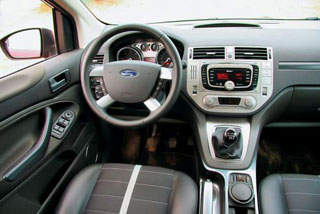 Today, Kuga has only one engine. This is a turbocharged 2.0 -litar diesel with a capacity of 136 hp. In the future, a 2.5 -liter gasoline power unit will appear. Tiguan, on the contrary, has no diesel in our market, but there are already two gasoline engines: 2.0 TSI and 1.4 TSI. For the test, we took a less powerful car with a 1.4 -liter 150 -horsepower gasoline unit. The engineers managed to get such a good power indicator from this not the most voluminous motor thanks to the tandem of the turbine and compressor. And I must say, it turned out great! Those one and a half tons with a small that Tiguan has in the equipped mass, for it a mere trifle. The dynamics of the car is simply wonderful. The only thing you need to get used to the fact that the first gear is too short, as, however, are not very stretched. As a result, I did not have time to move, as it should already be crossed a step higher, and so on the growing one. In this regard, the riding is quite torn. In general, dexterity is required. Kuga, thanks to the diesel, is not so demanding of the selection of transmissions, but it also suffers from lack of traction at low speeds.
Today, Kuga has only one engine. This is a turbocharged 2.0 -litar diesel with a capacity of 136 hp. In the future, a 2.5 -liter gasoline power unit will appear. Tiguan, on the contrary, has no diesel in our market, but there are already two gasoline engines: 2.0 TSI and 1.4 TSI. For the test, we took a less powerful car with a 1.4 -liter 150 -horsepower gasoline unit. The engineers managed to get such a good power indicator from this not the most voluminous motor thanks to the tandem of the turbine and compressor. And I must say, it turned out great! Those one and a half tons with a small that Tiguan has in the equipped mass, for it a mere trifle. The dynamics of the car is simply wonderful. The only thing you need to get used to the fact that the first gear is too short, as, however, are not very stretched. As a result, I did not have time to move, as it should already be crossed a step higher, and so on the growing one. In this regard, the riding is quite torn. In general, dexterity is required. Kuga, thanks to the diesel, is not so demanding of the selection of transmissions, but it also suffers from lack of traction at low speeds. In terms of controllability on the asphalt, cars are very similar. Unless, due to the lower profile of rubber and larger diameter of the wheel wheels, the Kuga was less susceptible to carrier from the trajectory. However, as they say, there is no thin one without good. It was precisely due to the fact that Volkswagen was shod in tires with a large profile, his tread on uneven asphalt was much softer, and therefore more comfortable.
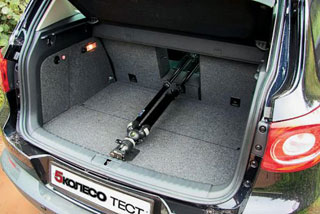 As for the light off -road, both cars are well adapted to it. Unless due to the Off Road package and the best geometric patency due to the smaller wheelbase and insignificant front and rear overhangs, Tiguan is slightly more agile Kuga on the hills and excesses. By the way, the clearance of cars is the same and is 195 cm. Not much, of course, but if you take into account that most of their lives, these cars, like any other crossover, will be carried out on the asphalt, is quite enough.
As for the light off -road, both cars are well adapted to it. Unless due to the Off Road package and the best geometric patency due to the smaller wheelbase and insignificant front and rear overhangs, Tiguan is slightly more agile Kuga on the hills and excesses. By the way, the clearance of cars is the same and is 195 cm. Not much, of course, but if you take into account that most of their lives, these cars, like any other crossover, will be carried out on the asphalt, is quite enough. Our verdict
In terms of its characteristics, both Ford Kuga and Volkswagen Tiguan are very similar. In this connection, it is very difficult to clearly arrange places. However, in our view, the scales bowl are nevertheless inclined towards Tiguan, and first of all because, unlike Kuga, its potential in our market is much higher due to the possibility of choosing both between modifications and the type of drive. The Trend & Fan version, the appearance of which is expected soon, will be monotive and intended for use mainly on the roads of the city.
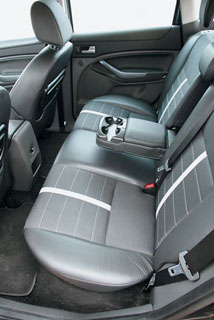 Database
Database Dimensions, weight
The number of places 5 - 5
Equipped mass, kg 1545 - 1540
Full mass, kg 2170 - 2060
Length, mm 4425 - 4440
Width, mm 1810 - 1840
Height, mm 1685 - 1710
Base, mm 2605 - 2690
Trunk volume, l 5051510 - 3601355
Fuel tank volume, l 64 - 58
Dynamics
Maximum speed, km/h 192 -180
Acceleration time to 100 km/h, from 9.6 - 10.7
Braking distance at a speed of 100 km/h, from 35 - 37
Control consumption of fuel, l/ 100km:
city cycle 10.6 - 8.0
country cycle 7.0 - 5.3
mixed cycle 8.4 - 6.4
Technics
The type of engine is gasoline - diesel,
in line, 4-cylinder-in a line, 4-cylinder
Working volume, cm3 1390 - 1997
Power L.S. at MIN -1 150/5800 - 136/4000
Torque at MIN -1 240/1750 - 320/2000
Transmission 6-speed, mechanical-6-speed, mechanical
Full drive - full
The front wheels suspension is independent - independent
The rear wheels suspension is independent - independent
The front brakes, ventilated - disk, ventilated
Rear disc brakes - disk
Steering with an amplifier - with an amplifier
Tire size 215/65R16 - 235/55R17
Clerence, mm 195 - 195
Author: Oleg Kalaushin
Photo: Igor Kuznetsov
A source: Magazine 5 wheel [October 2008]
Video Test Drive Ford Kuga since 2008
Ford Kuga crash tests since 2008
Ford Kuga test drive since 2008
Ford kuga crash test since 2008
Krassh Test: Detailed Information33%
Driver and passengers
20%
Pedestrians
38%
Children-passengers

